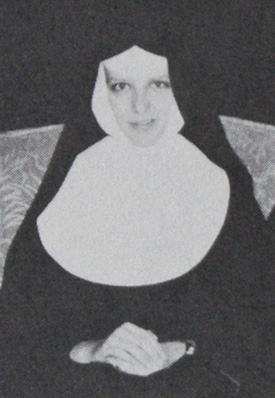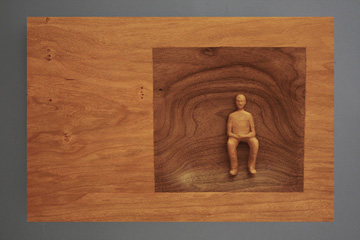|
From 1961 to 1973 I attended a small Catholic School, Saint John the Evangelist School, in Uniontown, Pennsylvania and received instruction under the tutelage of the Sisters of Saint Joseph of Baden, Pennsylvania. My first grade class numbered about thirty-five students and my graduating class was slightly larger. I'm not certain of the exact numbers anymore. This was in an era when most schools, particularly public schools, were consolidating and becoming much larger. My twelve year tenure at Saint John School was a unique experience that I came to appreciate more as the years passed and I became further removed from that era. While I was finishing my second novel, Cataloochee Man, the idea came to me to weave that experience into a work of fiction, and thus the idea for Saint John School (which was the original title to the novel) was born. My first thought was to compile a collection of short stories and anecdotes that characterized my time there and through this anthology, paint a picture of what that era was like from my perspective. Before I was too far into the project, however, I determined that this might become tiring to the reader (since it was becoming tiring to the writer) and I decided that I wanted a definite story line. In the course of the writing, which spanned five years, I went through some changes in my life, and as a result the original idea expanded into a somewhat autobiographic and especially introspective tale. |
|
I have long been a fan of the writings of Henry David Thoreau. In my twenties, I read Walden like some people read a bible, and the philosophy for living, outlined in the book, had a profound effect on the decisions I made regarding the course of my own life. From a literary point of view, I admired Thoreau's precise use of words, his sharp wit, and use of sarcasm. For some years, I attempted to live and write like Thoreau, and while not very successful at this enterprise, the influence of his words and his writing style have remained with me. I was introduced to the writing of Edward Abbey about thirty years ago when a family member who lived in the southwest gave me a copy of Desert Solitaire. Abbey was an American author and essayist noted for his advocacy of environmental issues and anarchist political views. A few years later, I read The Fool's Progress and it was this somewhat autobiographical novel that I had in mind as I worked on The Man in the Room. I began writing the story in 2007, shortly after finishing Cataloochee Man, but soon after, experienced some major changes in my life: a separation in my marriage and relocation to my present address. I struggled to keep the momentum going with the story throughout this transition, but I became so busy with other activities that eventually the writing stopped. About two years ago, I considered deleting the files because I didn't think I would ever continue working on them. One of the other activities that I became involved with was Toastmasters. Toastmasters is an organization dedicated to public speaking and leadership skill development. I joined in early 2007 because I had been asked to host a book-signing for Wooden Spoons, and was very nervous about speaking in front of a group. I remained a member for the next four years, because I came to enjoy the challenge of public speaking, something I had avoided throughout my life. While the emphasis was on speaking, much of the Toastmasters experience was about writing, and over the course of four years, I wrote thirty-five original speeches. The challenge of condensing a topic into a seven minute speech that was to be presented to an audience taught me to be concise with vocabulary and imaginative with my storytelling. I also came to appreciate the value of humor, particularly self-deprecatory humor, in getting a message across. This was an attribute of Edward Abbey's writing that I enjoyed, and while I did not wish to imitate Abbey's abrasive and outspoken style (although I do appreciate it) I did hope to emulate his humor, particularly his self-deprecatory humor. A humorous speech I gave, entitled How I got out of the Boy Choir, was directly incorporated into the novel. Another speech, The Man in the Room, became the basis for an entire chapter and, over time, the idea behind this speech gradually became the underlying theme for the story. When I chose to end the novel in the same way the speech concluded, I felt that the same title was appropriate. I started working on this novel again in January of 2012, working nearly every morning for several hours at a time. The Man in the Room was completed about a year later, and published first in Kindle format on Christmas Day, with the paperback following several weeks later. |
|
|
|
Most of the characters in The Man in the Room are based on people that I know or once knew, however I changed names and sometimes combined personality traits to go with a particular scene, or in the case of the main characters, to fit the story in general. Two of the characters, Sister Mary Sean and Tom Drew, are based directly on the actual persons, even to the extent that I used their real names. I chose to do this because they are two personalities that I recall fondly from the past, although for very different reasons. Both are described and quoted just as I remember them. The picture to the left is of Sister Mary Sean in about 1963, the time period when she is mentioned in the story. Tom Drew was a barge hand that I worked with when I was employed by my father in Point Marion, Pennsylvania in 1973. He was in his late fifties then and I was eighteen, and we became good friends. Tom was one of the most interesting characters I've met along the way, a little rough around the edges, but intelligent and witty, definitely someone who went his own way in life. The main character is based on me, of course, but this story was never meant to be an autobiography. I took complete liberty in changing and rearranging the facts, or creating new information. The character is autobiographical in the sense that his actions and attitude present a glimpse at what life has been like from my perspective, a vantage point that has always been a bit off the track. Let's say that the book is autobiographical, but the story is about half true. |
Sister Mary Sean |
|
|
|
As with Cataloochee Man and the second edition of Wooden Spoons, The Man in the Room was published entirely through my imprint, Walnut Creek Press. I feel to be quite the experienced publisher now. Actually, it's been so long since I published Cataloochee man that I had to work through the entire process again. I was determined to publish by the end of the year, but after numerous readings, was still not sure it was ready even late in December. And besides at this point, no one else had read it except for me. So I opted to publish The Man in the Room in kindle format first since this is a relatively simple process, and corrections can be made easily. As a present to myself, I published on Christmas Day, 2012. |
|
The Man in the Room |
After considering the feedback from friends and relations who read the kindle version, and working on the manuscript for a few more weeks, I published The Man in the Room in paperback format. The cover design came easily for me, because I had the idea worked out in my head for months. A detail of the wall carving, pictured to the left, was used for the front cover. The piece is titled The Man in The Room and was first done about fifteen years ago. I've completed a number of variations of this idea since and this latest version was carved with the cover in mind. (Click on image for more details.) For the back cover, I overlaid an image of Saint John High School in Uniontown, Pennsylvania (pictured below), which is the high school I graduated from in 1973. |
|
The Setting |
|
The story revolves around Saint Mathew's School, which is a takeoff of Saint John School, located in Uniontown Pennsylvania. Saint John High School is pictured to the right as it appears in about 1963. Since the building was demolished twenty years later, and the spot is now part of the church parking area, it exists only in pictures and memory. However, the other buildings still exist and with the exception of the music room, which serves as a kindergarten, are functioning in the same capacity. I graduated from Saint John High School in 1973 and describe the building much as I remember it. The school was in decline in those years and actually ceased functioning as a school two years after I graduated. The third floor was already condemned at this time and Brigadoon that I mentioned in the story was staged in another location. |
Saint John High School |
|
Homewood, Pennsylvania was loosely based on Uniontown, Pennsylvania with bits and pieces of other towns I've known woven in. The decline in prosperity after the great coal era did occur and was characteristic of many towns in southwestern Pennsylvania. Uniontown, fortunately has experienced a revival of sorts, although not exactly in the way I describe it. A few years back when I was in transition, and had begun writing this novel, I considered moving back to that area, more particularly to Hopwood, a little town a few miles from Uniontown, where I grew up. But my family is mostly scattered now and the timing didn't seem right-perhaps too late-and I decided to remain in North Carolina. Janesville, North Carolina, was Waynesville where I lived for ten years and had a gallery on Main Street. After that, the rest is mostly fiction. The gallery was closed and the building sold in 2007, at which time my wife and I quietly and amicably separated. I moved to Marshall, North Carolina, a little town in Madison County where I set up a new studio and after a period of adjustment, finished The Man in the Room. |



